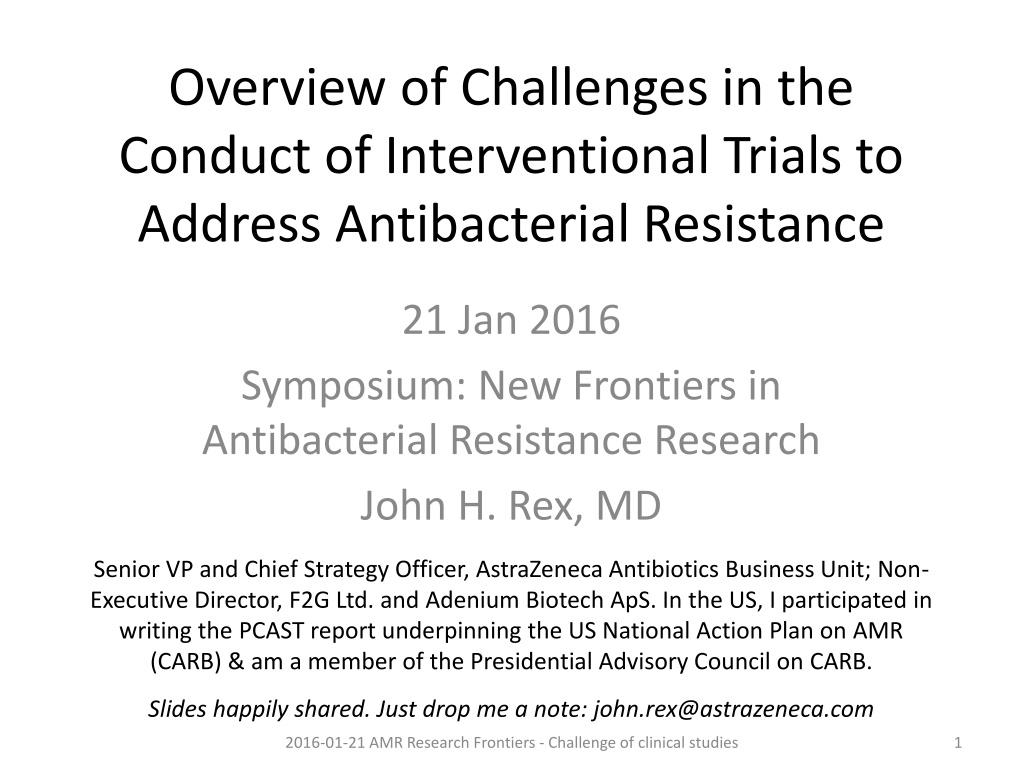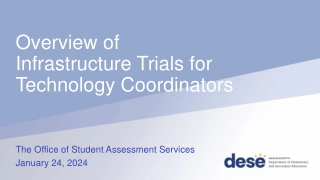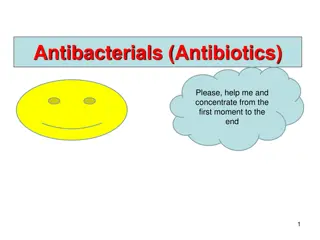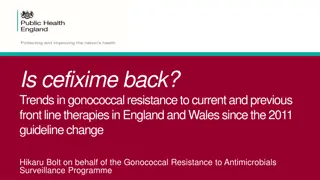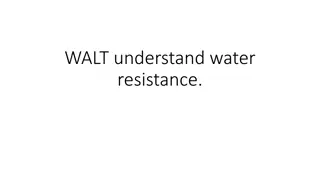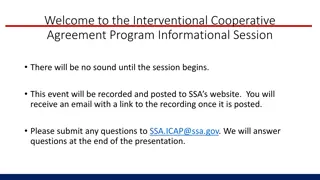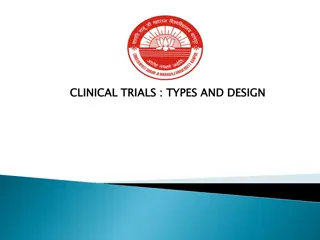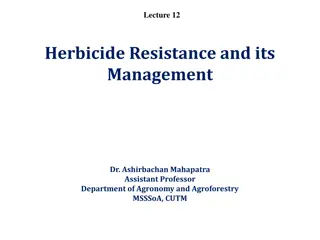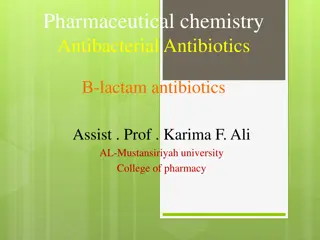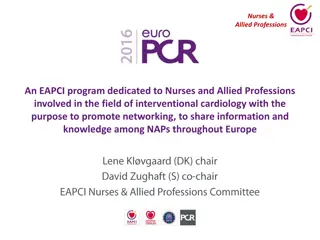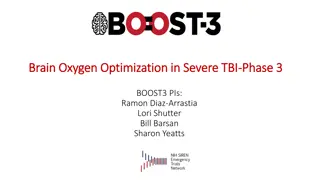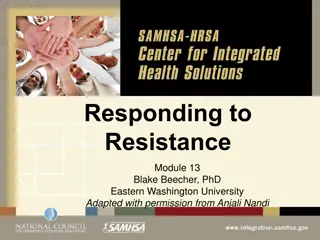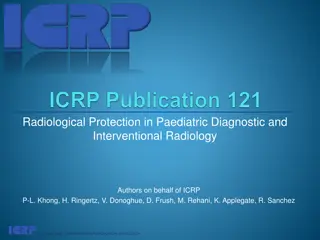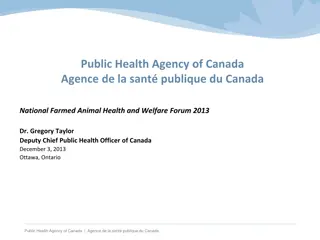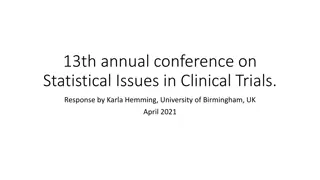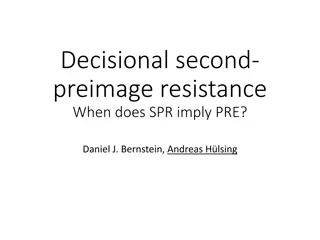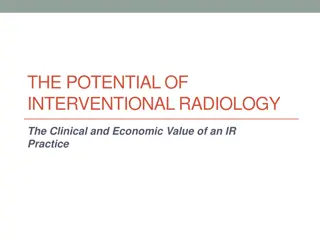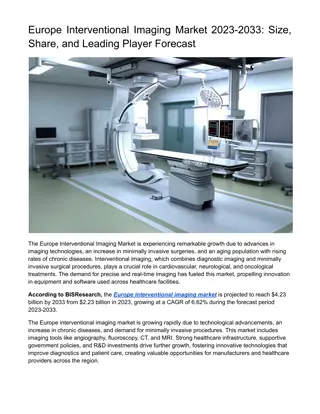Challenges in Conducting Interventional Trials for Antibacterial Resistance
Addressing antibacterial resistance through interventional trials presents challenges relating to nomenclature, trial design implications, and the continuous evolution of resistant bacteria categories. The discussion emphasizes the need for a sustained pipeline of novel therapies to combat resistance effectively. Key points include differentiating resistant bacteria categories, understanding the continuum from UDR to XDR, and considering the implications for trial comparator selection. Ultimately, the goal is to overcome these challenges to develop effective treatments against antibacterial resistance.
Download Presentation

Please find below an Image/Link to download the presentation.
The content on the website is provided AS IS for your information and personal use only. It may not be sold, licensed, or shared on other websites without obtaining consent from the author. Download presentation by click this link. If you encounter any issues during the download, it is possible that the publisher has removed the file from their server.
E N D
Presentation Transcript
Overview of Challenges in the Conduct of Interventional Trials to Address Antibacterial Resistance 21 Jan 2016 Symposium: New Frontiers in Antibacterial Resistance Research John H. Rex, MD Senior VP and Chief Strategy Officer, AstraZeneca Antibiotics Business Unit; Non- Executive Director, F2G Ltd. and Adenium Biotech ApS. In the US, I participated in writing the PCAST report underpinning the US National Action Plan on AMR (CARB) & am a member of the Presidential Advisory Council on CARB. Slides happily shared. Just drop me a note: john.rex@astrazeneca.com 2016-01-21 AMR Research Frontiers - Challenge of clinical studies 1
Point of View I am a board-certified internist & ID specialist This talk summarizes 28 years of experience Academia, large pharma, and small pharma, Antibacterial drugs & antifungal drugs, Regulatory agencies around the world, and Product success and product failure Core bias: Even when drugs are used correctly, development of resistance is inevitable We need a sustained, vibrant pipeline of novel therapies This talk is about ~90% focused on the issues around developing those novel therapies 2016-01-21 AMR Research Frontiers - Challenge of clinical studies 2
Agenda Challenge: Nomenclature and its implications Scope: What questions will we study? Challenge: Core paradoxes Synthesis: Possible ways forward Summary 2016-01-21 AMR Research Frontiers - Challenge of clinical studies 3
Nomenclature: resistant bacteria There s a nomenclature problem that gets in the way of clear communication and thinking When we say I want to know how Drug X works on resistant bacteria , we actually mean How does Drug X work on bacteria that are susceptible to Drug X and resistant to other drugs? But, all bacteria are resistant to some drugs and susceptible to others How do we separate this idea from MDR and XDR? 2016-01-21 AMR Research Frontiers - Challenge of clinical studies 4
1. Nomenclature: UDR vs. MDR/XDR It is helpful to see bacteria across 3 categories, not 2 UDR: Usual Resistance1 MDR: Multi-drug resistance XDR: Extensive multi-drug resistance This is a continuum with implications for trial design UDR: Many easy choices. Easy to choose a blinded comparator. MDR: Harder may need 2nd-line drug.2 Single comparator is harder XDR: Needs a difficult or unusual drug.2 Comparator must be ad hoc. Things that are UDR today can be MDR tomorrow Example of MRSA: once seen as MDR, it s now seen as UDR If you deliver an adequate exposure of an active drug Response is independent of being UDR, MDR, or XDR to other drugs 1This may or may not be the same thing as wild-type. See discussion of MRSA below. 3Or combination of drugs 2016-01-22 Transatlantic collaboration - Keynote - AMR Clinical Research 5
UDR vs. MDR vs. XDR Frequency Common Rare Standard comparator Easy Hard UDR MDR XDR Activity of NEW DRUG is independent of being UDR, MDR, or XDR to other drugs. NEW DRUG S S S Approved Drug #1 S S S? Approved Drug #2 S S R Approved Drug #3 Approved Drug #4 S S S R R R With adequate PK, efficacy vs. UDR predicts effficacy in MDR or XDR. Approved Drug #5 Approved Drug #6 S S R R R R Approved Drug #7 R R R 2016-01-22 Transatlantic collaboration - Keynote - AMR Clinical Research 6
Nomenclature: Consequences We can now restate I want to know how Drug X works on resistant bacteria as How does Drug X work on bacteria that are susceptible to Drug X and UDR (or MDR or XDR) to other drugs? This also exposes a second question: If an isolate is susceptible to Drug X, does being UDR, MDR, or XDR to other drugs make a difference? Stated differently, does the MIC to Drug X capture everything you need to know or not? 2016-01-21 AMR Research Frontiers - Challenge of clinical studies 7
Is all the information in the MIC? (1) Two possibilities exist. Here s the first: Might two isolates with the same MIC to Drug X but different MICs to Drug Y have different responses to Drug X? No. This has been convincingly proven untrue Provided you deliver an adequate drug exposure to the site of infection, then the MIC is the key Dr. Baquero also made this point yesterday. If you use a properly dosed and active drug, then outcomes are not worse for MDR/XDR infections 2016-01-21 AMR Research Frontiers - Challenge of clinical studies 8
Is all the information in the MIC? (2) But, might two patients infected with isolates with the same MIC to Drug X but different MICs to Drug Y have different responses to Drug X? YES (1) MDR/XDR carriage is a marker of exposure to health care This links to higher frequencies of co-mordid conditions And underlying disease of course influences outcome Yes (2) PK of Drug X may be different in the critically ill This is part of the background of different co-morbidities Key: The difference is not directly due to the drug! 2016-01-21 AMR Research Frontiers - Challenge of clinical studies 9
With that in mind So now when we ask How does Drug X work on bacteria that are susceptible to Drug X and UDR (or MDR or XDR) to other drugs? We can see that useful data can be obtained from UDR, MDR, or XDR infections If you ensure the PK is adequate at the site of infection, All the relevant data about the portion of the clinical outcome that can be influenced by antibiotic therapy are in the MIC to Drug X 2016-01-21 AMR Research Frontiers - Challenge of clinical studies 10
Why does this matter? It s much harder to do prospective, randomized, registration-quality studies in patients with infections due to MDR/XDR isolates than due to UDR isolates AZ data: It s twice as slow and costs twice as much Patients must present at a study site as referral is hard Receiving a patient with an MDR/XDR infection is not popular Infections move rapidly therapy must start now Sites work hard to make MDR and XDR rare! No site wants to be a Center of MDR/XDR Excellence! Chasing MDR/XDR is very frustrating: Lasagna s Law1 in action And, we want MDR/XDR rates to stay low!! If it s easy to recruit MDR/XDR, something is very wrong 1Louis Lasagna: The incidence of patient availability sharply decreases when a clinical trial begins and returns to its original level as soon as the trial is completed. http://www.pmean.com/11/lasagna.html 2016-01-21 AMR Research Frontiers - Challenge of clinical studies 11
Agenda Challenge: Nomenclature and its implications Scope: What questions will we study? Challenge: Core paradoxes Synthesis: Possible ways forward Summary 2016-01-21 AMR Research Frontiers - Challenge of clinical studies 12
What should we study? Reminder: For today, I am focusing on the type of prospective randomized trials needed for drug registration. Other trial design types (observational, non-randomized trials, etc.) do not generally suffice for this purpose. When antibiotics are needed, is Drug X effective? Is Drug X better than no drug (placebo)? Is Drug (the same as) (better than) Drug Y? Are there times when Drug X is not a good choice? Infection-related: Is Drug X effective at site Z? How does Drug X work for UDR vs. MDR/XDR isolates? Patient-related: How do we dose Drug X in the face organ dysfunction or drug-drug interactions? Today s focus. How do we do this? 2016-01-21 AMR Research Frontiers - Challenge of clinical studies 13
Agenda Challenge: Nomenclature and its implications Scope: What questions will we study? Challenge: Core paradoxes Non-inferiority trials are the only long-term path Pathogen-focused pathways are currently elusive Endpoints must be clinical Antibiotic alternatives face a mix of these issues Synthesis: Possible ways forward Summary 2016-01-21 AMR Research Frontiers - Challenge of clinical studies 14
Ethical study designs In animal models, we can study all variations of UDR to MDR to XDR Placebo, ranges of doses, combinations of drugs But, we can only do a limited amount of this in man Placebo is only possible in very low acuity infection Indeed, only when we agree that NO therapy is actually OK This eliminates most important infections from study It s hard to enroll MDR/XDR infections in man See prior slides and we want this to always be true And, we must always provide a good therapy Can t deliberately underdose or ignore MDR/XDR Effectively, we design studies to make superiority rare 2016-01-21 AMR Research Frontiers - Challenge of clinical studies 15
Consequences: Non-inferiority (NI) studies are (usually) key to progress Pivotal data on new antibiotics will almost always be from non-inferiority (NI) comparisons (new) Drug X vs. (old) Drug Y at full doses of each All isolates susceptible to X and Y Expect to see X Y within some confidence limit Yes, superiority studies would be so much easier! Superiority studies are self-validating Superiority studies at times are much smaller 80% vs. 20% can be shown with N = ~20/arm! But, that s not where we usually are (or want to be!) 2016-01-21 AMR Research Frontiers - Challenge of clinical studies 16
I see no consistent way out of this Historical controls showing superiority to placebo? Tricky outside very predictable diseases (e.g., meningitis?) And, comparisons vs. current therapies will still be needed Wait for MDR/XDR to become sufficiently common that clinical trials vs. same are easy to do? Obviously not! It takes 10+ years to create new therapies Nested superiority from a subset of an NI trial? You can always look for this (e.g., DOORS/RADAR idea) But, this should be unlikely in registration trial as you can t deliberate undertreat a subset Beat a drug on toxicity? Might do this once (e.g., beat colistin on toxicity) Registration of the first new less-toxic drug ends this path 1Evans, S. R., D. Rubin, et al. (2015). "Desirability of Outcome Ranking (DOOR) and Response Adjusted for Duration of Antibiotic Risk (RADAR)." Clin Infect Dis 61(5): 800-806. 2016-01-21 AMR Research Frontiers - Challenge of clinical studies 17
Agenda Challenge: Nomenclature and its implications Scope: What questions will we study? Challenge: Core paradoxes Non-inferiority trials are the only long-term path Pathogen-focused pathways are currently elusive Endpoints must be clinical Antibiotic alternatives face a mix of these issues Synthesis: Possible ways forward Summary 2016-01-21 AMR Research Frontiers - Challenge of clinical studies 18
Pathogen-focused development This mental schema was developed 2012-13 P3 x 2 Reliance on human PK data combined with preclinical efficacy data A Quantity of Clinical Efficacy Data that you can generate Animal rule D Acceptance of smaller clinical datasets in response to unmet medical need Rex et al. Lancet Infect Dis 13: 269-75, 2013. Rex et al. Ann NY Acad Sci 2014, DOI 10.1111/nyas.12441. 2016-01-21 AMR Research Frontiers - Challenge of clinical studies 19
Pathogen-focused development This mental schema was developed 2012-13 P3 x 2 Reliance on human PK data combined with preclinical efficacy data A P3 x 1 plus small studies Quantity of Clinical Efficacy Data that you can generate B Small studies Animal rule C Pathogen -focused D Acceptance of smaller clinical datasets in response to unmet medical need Rex et al. Lancet Infect Dis 13: 269-75, 2013. Rex et al. Ann NY Acad Sci 2014, DOI 10.1111/nyas.12441. 2016-01-21 AMR Research Frontiers - Challenge of clinical studies 20
Typical Tier B & Tier C Programs1 Good candidate drug for Tier B vs. Tier C Tier B: Sufficiently broad spectrum that monotherapy for a syndrome such as intra-abdominal infection is possible Tier C: A narrow-spectrum agent that covers but one of many possible pathogens in a syndrome 2016-01-21 AMR Research Frontiers - Challenge of clinical studies The Phase 3 development program for these drugs is then (Tier B): Drug X vs. a standard comparator at one body site2 Non-inferiority design study that enrolls only UDR pathogens PK-PD provides link to activity vs. MDR & XDR pathogens (Tiers B and C):Resistant pathogen study: Drug X vs. Best Available Therapy (BAT) for MDR or XDR pathogens Prospective, randomized, open-label, and (mostly) descriptive N a few hundred. Multiple body sites. 1The example presumes that a clear exposure target is known from preclinical PK-PD and that there is a clear ability to produce a corresponding drug exposure in patients. See literature (Rex et al. Lancet Infect Dis 13: 269-75, 2013) for detailed examples. 2E.g., pneumonia or UTI 21
Tier B is universal. Tier C is not. EMA Antibacterial guidance (2013) Explicit description of options that match Tiers B & C FDA Antibacterial guidance (2013) Explicit description of options that match the Tier B ideas Unless the data permit inferential testing, Tier C is not possible for FDA This position was re-affirmed as recently as ICAAC 2015 Translation to action For a narrow-spectrum (Tier C) drug for (say) Pseudomonas You d seek the largest possible dataset on infections with it at a single body site. You d then argue for a wide margin on the NI comparison Personal experience: VERY hard, even with rapid diagnostics Superiority on pooled data across body sites could be accepted, but this requires optimistic assumptions that I don t like We need to work on better ways to do this 2016-01-21 AMR Research Frontiers - Challenge of clinical studies 22
Agenda Challenge: Nomenclature and its implications Scope: What questions will we study? Challenge: Core paradoxes Non-inferiority trials are the only long-term path Pathogen-focused pathways are currently elusive Endpoints must be clinical Antibiotic alternatives face a mix of these issues Synthesis: Possible ways forward Summary 2016-01-21 AMR Research Frontiers - Challenge of clinical studies 23
Endpoints must be clinical For drug development, we expect the primary endpoint to be based on something related to how you (the patient) feel, function, or survive Cultures and lab tests do not (usually) qualify No one ever says, Doc, my cytokine levels are too high! They say instead, Doc, I don t feel well. A developer is free to use non-clinical measures for dose-selection or other early proof of concept Example: Speed of sputum culture conversion in TB But, you ultimately must show clinical benefit This is a common point of confusion 2016-01-21 AMR Research Frontiers - Challenge of clinical studies 24
Agenda Challenge: Nomenclature and its implications Scope: What questions will we study? Challenge: Core paradoxes Non-inferiority trials are the only long-term path Pathogen-focused pathways are currently elusive Endpoints must be clinical Antibiotic alternatives face a mix of these issues Synthesis: Possible ways forward Summary 2016-01-21 AMR Research Frontiers - Challenge of clinical studies 25
Developing Alternative Therapies1 If it has the efficacy of a standalone antibiotic: Then see above: Develop as such If an add-on (e.g., many anti-virulence approaches) Then you are forced into Antibiotic vs. Antibiotic + Add-On Need to show superiority in the +Add On arm A high hurdle: We re going to maximize the Antibiotic (full dose!) and provide as much secondary support as we can This should not be thought of as a regulatory hurdle! None of us will use Add On if we can t see what it offers Also, many Alternatives are narrow-spectrum See discussions above the same problems apply 1Prevention (e.g., vaccines) is also good but is a separate topic! 2016-01-21 AMR Research Frontiers - Challenge of clinical studies 26
Agenda Challenge: Nomenclature and its implications Scope: What questions will we study? Challenge: Core paradoxes Synthesis: Possible ways forward Summary 2016-01-21 AMR Research Frontiers - Challenge of clinical studies 27
Implications for new drugs If at all possible, generate a standard dataset on new Drug X vs. excellent comparator Y in UDR infections Do this in a standard serious infection (e.g., cIAI) The focus on UDR is not as limiting as it might sound: If Y is a penem, can study anything but penem-R Data like this underpin every drug we currently use The data you can generate in MDR/XDR are limited and often anecdotal in nature I understand the (emotive) wish for these data But, the science of PK-PD is real and predictable Diagnostics will help a bit but aren t a complete fix See above: We want MDR/XDR to be rare! 2016-01-21 AMR Research Frontiers - Challenge of clinical studies 28
FDA at ICAAC 20151 Top 5 mistakes made by sponsors Development Program Sponsor preference for a more difficult program targeting a relatively infrequently occurring resistance phenotype vs. a more feasible pathway such as a study in an all-comer population at a single body site of infection. * *My commentary: I think this is largely self-explanatory. In brief, FDA is telling us that they re seeing programs struggle to study MDR/XDR and that UDR-focused development makes sense to them. 1Excerpted from a presentation by Sumati Nambiar 2016-01-21 AMR Research Frontiers - Challenge of clinical studies 29
MHRA (EMA) at ICAAC 20151 Top 5 mistakes made by sponsors In a discussion of a hypothetical agent with activity vs. carbapenem-resistant Enterobacteriaceae (CRE): The indication will not be for treatment of CRE.* There is no need to acquire large amounts of nonclinical or clinical data on activity vs. CRE for an agent whose activity is clearly unaffected by resistance to other classes. *My commentary: This point merits unpacking. As there is no guarantee that every CRE isolate is susceptible to the new drug, the indication will be for treatment of infections due to New Drug-susceptible strains of Enterobacteriaceae. Resistance to other drugs is usually not mentioned in product labeling. 1Excerpted from a presentation by Mair Powell 2016-01-21 AMR Research Frontiers - Challenge of clinical studies 30
Translation to action We need to support a diverse pipeline Delighted to see the discussions at this meeting! In parallel, I m working hard on reimbursement Big press release1 today: Call for ways to delink reimbursement from usage as current model is akin to paying firemen per fire In terms of the science New agents are most reliably developed in comparative NI studies vs. a standard comparator for UDR infections International collaboration is needed on these studies (next slide) Anecdotal data on MDR/XDR can be generated in parallel Not a cornerstone for registration but still interesting International collaboration is hugely important here If it s ever easy to study MDR/XDR, we ve done something wrong! 1 Full text can be found on the UK AMR Review website: http://amr-review.org/industry-declaration 2016-01-21 AMR Research Frontiers - Challenge of clinical studies 31
UDR trial networks as a tool1 Focus on well-characterized standard infections with well-understood study designs (see next slide) Protocol is drug-independent Network is always running Sites are stable & well-trained Recruiting UDR infections is predictable and efficient Study drugs added at will Significant benefits possible Time benefit could exceed that of priority review Year 1 Year 2 Year 3 Control A Control B Test 1 Test 2 Test 3 No site initiation delays No time lost to learning the protocol and ramping up Sharing of controls should be possible would shrink N required, thus saving time & cost Bio-creep risk eliminated 1McDonnell, Rex, Goosens, Bonten, & Fowler: Manuscript in preparation 2016-01-21 AMR Research Frontiers - Challenge of clinical studies 32
Well-characterized infections I would focus a UDR network on any of the 5 serious infections for which we have clear trial designs cUTI, cIAI, HABP/VABP, CABP, and ABSSI1 These serious infections are all well-characterized, occur regularly, have predictable rates of morbidity and mortality, and have well-understood study designs Studies of important but less common infections (e.g., endocarditis) are slow to enroll & hard to blind 1cUTI: complicated urinary tract infection, cIAI: complicated intra-abdominal infection, HABP/VABP: hospital-associated or ventilator associated bacterial pneumonia (aka NP, or Nosocomial Pneumonia), CABP: community-acquired bacterial pneumonia, ABSSSI: acute bacterial skin or skin-structure infection 2016-01-21 AMR Research Frontiers - Challenge of clinical studies 33
Agenda Challenge: Nomenclature and its implications Scope: What questions will we study? Challenge: Core paradoxes Synthesis: Possible ways forward Summary 2016-01-21 AMR Research Frontiers - Challenge of clinical studies 34
Summary For new agents, MIC and PK at the site are the keys Do not fall into the MDR/XDR fallacy 1 Provide you ensure similar PK, data on UDR infections predict response to MDR/XDR Yes, the patients with MDR/XDR and comorbidities may well do worse but this would be true for any drug NI studies on UDR pathogens are often the best tool They can reliably generate clear, clean data Trial networks could powerfully support new agents Frustratingly, pathogen-focused registration is elusive I m looking hard for a Supreme Court case to resolve this 1Paul Ambrose 2016-01-21 AMR Research Frontiers - Challenge of clinical studies 35
Thank you! 2016-01-21 AMR Research Frontiers - Challenge of clinical studies 36
Backups 2016-01-21 AMR Research Frontiers - Challenge of clinical studies 37
Slide borrowed & adapted from Paul Ambrose EXPOSURE & RESPONSE IN MICE ESBL Versus Non-ESBL Producing Strains UDR (non-ESBL) MDR (ESBL) Response The UDR and MDR dots overlap when a drug active vs. both is studied. This has been shown in many settings, in vivo and in man. Active drug (relative to MIC) Dr. Baquero s showed this on Wednesday: MDR infections have the same outcome if you use an active drug. Craig WA and Andes DR. Treatment of infections with ESBL-producing organisms: pharmacokinetic- pharmacodynamic considerations. Clin Microbiol Infect. 2005;11:10-17. 2016-01-21 AMR Research Frontiers - Challenge of clinical studies 38
No placebo, no dose-ranging This is worth another slide In a comparative study in man, we can t enroll if we think the comparator might be inadequate We expect curative therapy for infections Further, we must always use a strong comparator Using a weak comparator leaves bio-creep1 concerns In short, we design our trials to make superiority unlikely If superiority is plausible because current choices are inferior or toxic (or both, such as colistin), then The window for superiority closes when a new therapy is introduced We should be pleased when we have this problem! If it s easy (or plausible) to show superiority, then we re in a situation similar to that with the Ebola virus 1TOdem-Davis K, Fleming TR. A simulation study evaluating bio-creep risk in serial non-inferiority clinical trials for preservation of effect. Statistics in Biopharmaceutical Research 2015;7:12-24. 2016-01-21 AMR Research Frontiers - Challenge of clinical studies 39
